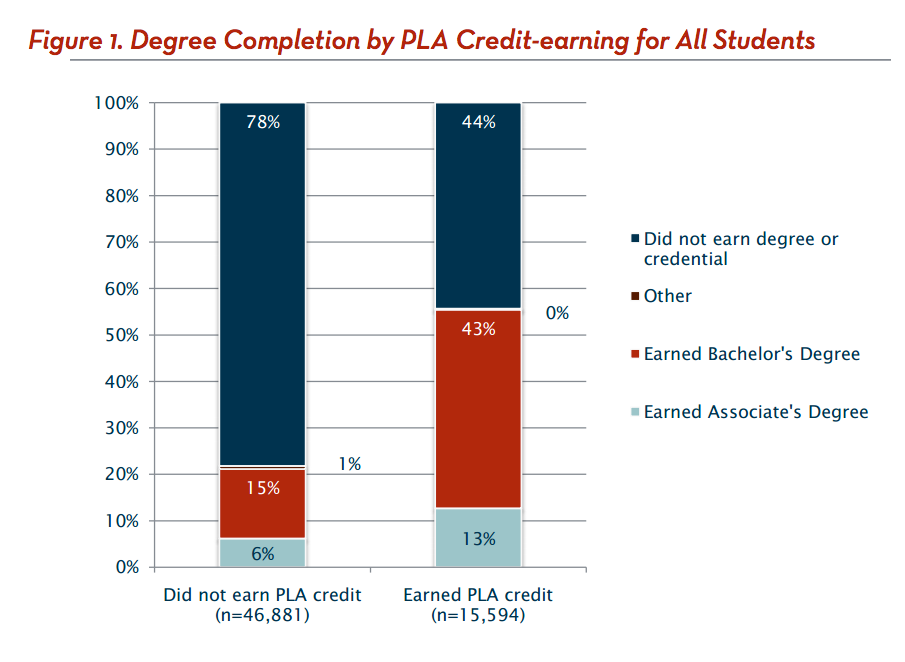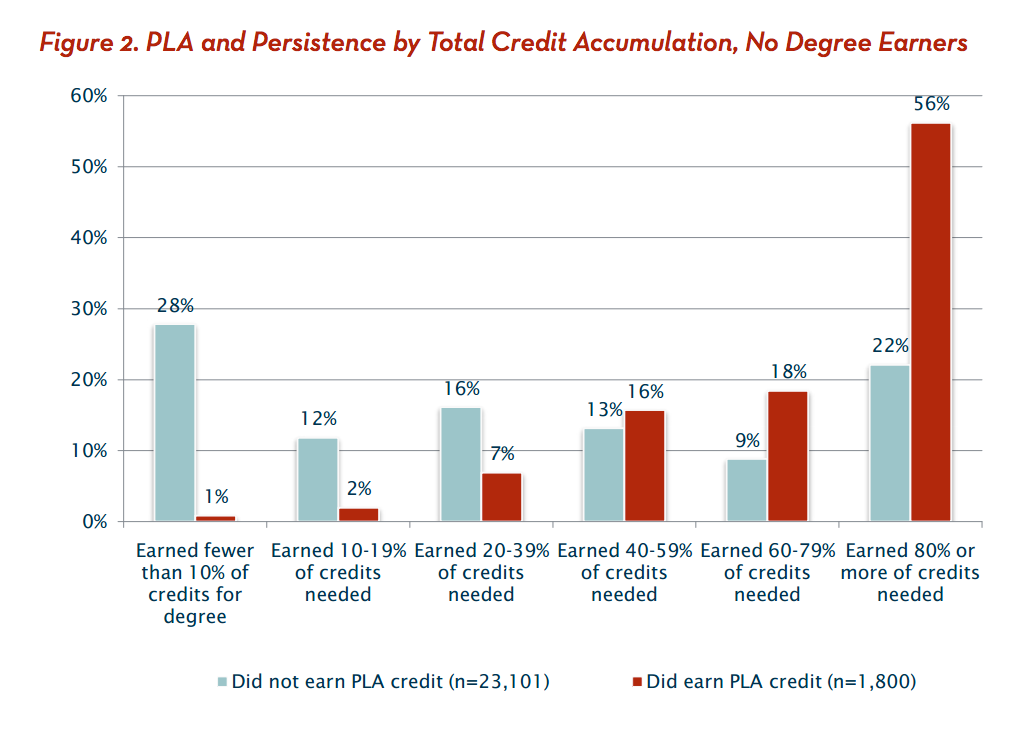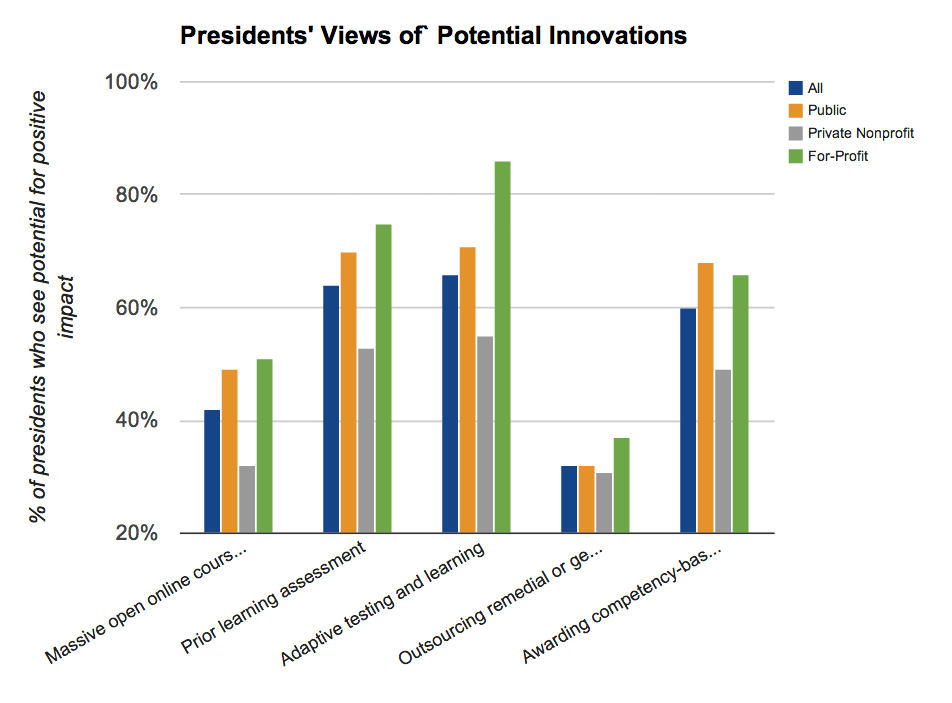Last week Steve Kolowich wrote in the Chronicle of Higher Education about the State University of New York (SUNY) system approval of a plan that would target reduced time-to-degree.
The State University of New York’s Board of Trustees on Tuesday endorsed an ambitious vision for how SUNY might use prior-learning assessment, competency-based programs, and massive open online courses to help students finish their degrees in less time, for less money.
The plan calls for “new and expanded online programs” that “include options for time-shortened degree completion.” In particular, the board proposed a huge expansion the prior-learning assessment programs offered by SUNY’s Empire State College.
Although the MOOC angle led the article’s title and online discussion, there was more significant news in terms of structural change regarding Prior Learning Assessments (PLA).
Even before the SUNY announcement, it had already been a big week for nontraditional models for awarding college credit. The U.S. Education Department on Monday said it had no problem with spending federal student aid on college programs that give credit based on “competency,” not the number of hours students spend in class.
Empire State College’s prior-learning assessment programs operate on a similar principle. Students who can demonstrate that they have acquired certain skills can get college credit, even if they did not acquire those skills in a college classroom.
The new SUNY effort will aim to copy the Empire State model across the system, said Nancy L. Zimpher, the chancellor.
“This resolution opens the door to assurances to our students that this kind of prior-learning assessment will be available eventually on all our campuses,” said Ms. Zimpher in an interview.
Background on PLA
Prior Learning Assessment, or PLA, is a little-discussed strategy to facilitate time-to-degree, particularly for non-traditional students. The concept is to set up the structure and processes to evaluate corporate training from employment, military training, civic responsibilities, travel, and independent study and award academic credit from these out-of-the-classroom learning situations. As the higher education population diversifies with much higher percentages of working adults, PLA can be an important factor in reducing total cost and time-to-degree.
In 2010 the Council For Adult & Experiential Learning (CAEL) published a study that was funded by the Lumina Foundation. Some of the key findings:
The data from 62,475 students at the 48 postsecondary institutions in our study show that PLA students had better academic outcomes, particularly in terms of graduation rates and persistence, than other adult students. Many PLA students also shortened the time required to earn a degree, depending on the number of PLA credits earned.
Paul Fain wrote last May at Inside Higher Ed about the quiet, but growing, role that PLA is taking within higher education policy circles.
But prior learning assessment mostly occurs behind the scenes, partially because colleges avoid loudly advertising that they believe college-level learning can occur before a student ever interacts with faculty members.
That low profile is ending, however, as prior learning is poised to break into the mainstream in a big way. The national college completion push and the expanding adult student market are driving the growth. And ramping up to meet this demand are two of the field’s early adopters — the Council for Adult and Experiential Learning and the American Council of Education — which may soon be even bigger players in determining what counts for college credit.
ACE is taking a lead role in trying to ensure quality standards in how PLA credits are awarded, and CAEL is playing a complementary role. Again from Fain’s article:
The association has decades of experience on prior learning assessment, as well as a large network of faculty credit evaluators and, perhaps most importantly, clout with its 1,600 college and university members.
“Who better than ACE to map out an adult learning agenda?” says Bataille.
Observers say prior learning’s impact on higher education could be enormous. Its potential could even rival that of online learning, by continuing to open student access beyond the campus, although the practice gets far less attention than splashy ventures like Sal Khan’s massively open online courses (MOOCs).
“Prior learning is the next phase,” says Ed Klonoski, president of Charter Oak State College, an online, public institution in Connecticut that conducts prior learning assessments. “It’s the next disruption.”
Loosely defined, there are four primary methods of assessing learning outside the classroom: through student portfolios; ACE credit recommendations based on corporate or military training programs; reviews conducted by individual colleges; and exams used to verify “learning achievements.” Those exams include the College Level Examination Program (CLEP), Excelsior College Exams and the DANTES Subject Standardized Tests.
Prior Learning Assessments and Competency-Based Education (CBE) – Brothers in Arms
Both PLA and CBE are based on the notion of moving beyond using seat time as the foundation of college credit, and both are biased towards non-traditional working adults. That’s why last week’s clarification from the Department of Education – that colleges can award financial aid based on “competencies” and not just seat time – is significant to both models. In Kelly Field’s article for the Chronicle, there was mention of this connection for PLAs.
Amy Laitinen, deputy director for higher education at the New America Foundation, said she hopes the department will expand its direct-assessment authority to remedial education and test the idea of awarding aid for prior-learning assessments.
“This letter really opens the doors to other things,” she said. “They are showing an interest in collaborating, in making this an ongoing conversation.”
Empire State College
Empire State College, a campus within SUNY, was one of the first colleges in the US to implement PLA and has provided credits in the third method mentioned above – “reviews conducted by individual colleges” – since the 1970s. Last year the Lumina Foundation awarded Empire State College a $500,000 grant to develop SUNY REAL (for Recognition of Experiential and Academic Learning) as a pathway for degree completion using open educational resources (OERs).
SUNY REAL, a two-year, $500,000 project, has the potential to expand capacity and access to higher education, increase the number of college graduates, decrease time to completion, reduce costs and assure quality.
The project will be a scaling up of the college’s nationally recognized programs for assessing college-level learning acquired outside of the formal higher education system; specifically, the project seeks to design, develop, deploy and disseminate a methodology to award credit for OER courses. Facilitating credit transfer and degree completion also are important aspects of the project. [snip]
Designed to be scalable and to serve all 64 SUNY campuses, SUNY REAL focuses on four key areas:
- assessment structures to evaluate verifiable, college-level, prior experiential and emergent learning for college credit
- recruitment and training of faculty and equivalent field experts for assessments
- transcription of the approved college-level learning
- ongoing research on its practices to ensure quality and consistency, and a link to the wider community of practice of noncollegiate learning assessment.
For more information Empire State College’s expanding role in open education, see this EDUCAUSE article.
Back to the SUNY Announcement
And this brings us back to last week’s news, in that SUNY has approved the expansion of SUNY REAL to cover all 64 campuses and potential audience of almost a half million students. What we now have is a project that would enable PLA-based credit for any SUNY student. From one of the press releases:
“We also are helping our students to translate real-world experience – such as military service or time in the workplace – into college credit,” said Zimpher. “Our program, which is under development at Empire State College, is called SUNY REAL. It will meet the learner where he or she is, and through prior-learning assessment by highly qualified faculty experts, will dramatically diminish the need for the repeat courses or costly skills training they already have. It is being designed for scale-up throughout SUNY.”
The SUNY effort, once implemented, would qualify it as the biggest implementation of PLA in the country, and I suspect it will raise the level of awareness around this important strategy. Consider also that in a recent survey of college and university presidents conducted by Gallup for Inside Higher Ed, there was strong support for the potential of competency-based education and Prior-learning assessments, which is another indication that PLA’s time has come.
There is fairly widespread enthusiasm about awarding academic credit based on students’ competency rather than seat time, with 21 percent of presidents strongly agreeing and another 39 percent agreeing that awarding competency- based credits has “great potential” for higher education. Support was stronger among public (68percent) and for-profit college presidents (66 percent) than among those in private nonprofit higher ed (49 percent).
Public sector presidents (26 percent) were more likely than private sector leaders (15 percent) to strongly agree that the use of prior learning assessments has potential for positive impact, and significantly larger numbers of presidents in most categories said they agree.
I expect we’ll see much more about PLA in the next few years.
Update: Added link to Empire State College article.



Sal Khan is creating MOOCs? I guess, if you define MOOCs with an amazing lack of precision. That seems to be a real problem in the education field, like when watching two people talk past each other because they have two different definitions of “experiential learning” and each think the other is using their definition. Otherwise, great article on PLAs. Thanks for all the great information.
Peter, I agree with you (that Sal Khan comment was from an article I quoted) about problems with language, especially trendy terms like MOOC, adaptive, analytics, etc. I didn’t want to distract from the real point of the post (PLAs), but obviously the lack of comment or editing can be distracting as well. Thanks for the note.
If one were to look at this like the automotive industry through the lens of Christensen’s “disruptive innovation” model. Then MOOC’s, PLA and the related variances thereof, including e-learning, are like adding “tail fins” or making certain, formerly optional accessories standard but with a cosmetic face lift. Bottom line? one needs/wants a car and in parallel, one needs/wants certification by degree. Yes, it’s nice to own a Porche or Cadillac but a Kia will get me to and from work. Similarly, it’s nice to have the ability to obtain a degree from a medallion institution with concomitant “value added” but, today, a “competency” based degree from a combination of formal courses, programs like Straighterline and similar paths gets the needed “calf-skin” but maybe in e-format?
When the bars have been raised from secondary to post secondary certification as a basic requirement, often the path of least resistance to get beyond 12 will do. And, I believe that there is data which shows that a practical ICT degree from a community college can out earn a more traditional path, if that is the current bottom line or rationale for getting beyond secondary certification.
Can we now sand blast away the lofty quotes from around the top of “old main”, the idea of a university?
More interestingly, if one considers intelligent systems an extension of the human mind instead of a tool, which many are thinking about at K-12 (think a personal expansion to the cloud with Siri or IBM’s Watson as seamlessly accessible), is this trend pushing for a more rapid obsolescence as the digital natives get beyond 12?
perhaps the humanities, ultimately, will have less to fear?